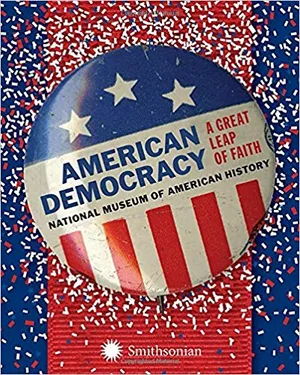History Was Writ Large on This Desk Belonging to Thomas Jefferson
The ingenuity of this clever writing box was matched only by the young republic’s innovative declaration for nationhood
:focal(-185x-285:-184x-284)/https://tf-cmsv2-smithsonianmag-media.s3.amazonaws.com/filer/cd/02/cd02140d-dc0e-4c31-ad75-7a969cf95b9e/jeffersondesk_.jpg)
At first glance, the mahogany writing box is unassuming. The reddish hinged case is neither as flashy as the tall Women’s Suffrage Wagon nor as darkly arresting as the Ku Klux Klan hood, both on display elsewhere in the National Museum of American History’s new exhibition, “American Democracy: A Great Leap of Faith.” But for curator Harry Rubenstein, the quietness of the writing case belies its true power as an artifact: it was the desk upon which Thomas Jefferson wrote the Declaration of Independence.
“There was Thomas Jefferson, in a rented room, writing on scraps of paper—things like stable receipts. He was putting together the thoughts that the committee would eventually pull together to draft the Declaration of Independence,” Rubenstein says.
The historic scene is all thanks to the evocative power of the writing box, and its indelible connection to the document the Founding Fathers used to build the United States of America.
In 1776, the Second Continental Congress met in Philadelphia to manage the war effort, make decisions about the formation of a new republic, and plea for help from France and Spain. Among those chosen for the committee that would write a document about why the colonies deserved independence from England were John Adams, Benjamin Franklin, Roger Sherman, Roger Livingston and Thomas Jefferson. As Jefferson was elected chair of the committee, the duty of writing a draft fell to him—and he had only 17 days to produce it.
At the time, Jefferson was staying in a rented room with cabinetmaker Benjamin Randolph—the very same person Jefferson had commissioned to build his writing box. Randolph was “the proprietor of one of the most successful cabinetmaking shops in Philadelphia during the 1760s and 1770s” writes antiques expert Andrew Brunk. Jefferson wasn’t Randolph’s only famous client; he also built pieces for George and Martha Washington. But Jefferson’s writing desk was a special build, in part because it came from its owner’s design—a symbol of inventiveness and ingenuity to go with the innovation of writing a declaration of nationhood.
“Jefferson always claimed the desk was by his own design, but it definitely was a collaboration between the two,” Rubenstein says. “While it seems like a simple desk, this takes a lot of carpentry skill.” Similar in shape to a modern briefcase, when the writing box is unfolded, it offers a slanted writing surface, a drawer to hold inkwells and quills, and plenty of room for paper. Like the writing desks owned by George Washington and Alexander Hamilton, Jefferson’s was meant to be portable, the tool of a man constantly on the move and constantly writing letters, documents and addresses.
And it certainly succeeded in helping him finish writing several drafts of the Declaration of Independence, which went on to be signed by other members of the Continental Congress—and eventually to have a huge impact on the fledgling nation. “The Declaration, precisely because it was a propaganda document, was addressed to the widest possible audience—to the whole ‘candid world,’ to that mankind whose opinion deserves a decent respect,” writes historian Gary Wills in Inventing America: Jefferson and the Declaration of Independence. “Thus the large formal parchment brought into the Congress on August 2 was kept available, over the next six months, for men to sign, joining their peers and predecessors. It gave men a kind of overnight antiquity and tradition because it was already outside time’s more immediate and practical challenges.”
That singular document wasn’t the only thing to come from Jefferson's writing box. The case traveled with him to France during his time as an ambassador; to Monticello when he returned to his home in Virginia; and to the White House when he became the country’s third president. Eventually he bequeathed the traveling desk to his granddaughter and her new husband, Eleanora and Joseph Coolidge when they were married in 1825. Based on the note he attached to his gift, Jefferson was well aware of the desk’s future importance:
“Politics as well as Religion has its superstitions. These, gaining strength with time, may, one day, give imaginary value to this relic, for its association with the birth of the Great Charter of our Independence,” he wrote.
Joseph Coolidge was no less effusive in his praise of the relic. “When I think of this desk, ‘in connection with the great charter of our independence,’ I feel a sentiment almost of awe, and approach it with respect; but when I remember that it has served you fifty years… I would fain consider it as no longer inanimate, and mute, but as something to be interrogated, and caressed.”
The desk passed from the Coolidge’s to the U.S. government in 1880, and from there to the Smithsonian Institution’s collection in the 1920s. The artifact has been on display at the American History Museum on and off ever since then, quietly prompting visitors to consider the Revolutionary era.
Jefferson’s self-importance and the accolades he bestowed upon his writing box are well merited in Rubenstein’s mind. “Is there a more important document in all American history?” he says of the Declaration of Independence. “[The Founding Fathers] were entering into an experiment that they had no idea of how it would turn out. The bigger experiment than even the revolution is this idea that you’re going to build a country around this democratic idea.”
Jefferson’s work in catalyzing the nation’s democratic experiment and other questions of American democracy can be considered in the new permanent exhibition “American Democracy: A Great Leap of Faith” at the Smithsonian's National Museum of American History in Washington, D.C.
/https://tf-cmsv2-smithsonianmag-media.s3.amazonaws.com/accounts/headshot/lorraine.png)

/https://tf-cmsv2-smithsonianmag-media.s3.amazonaws.com/accounts/headshot/lorraine.png)